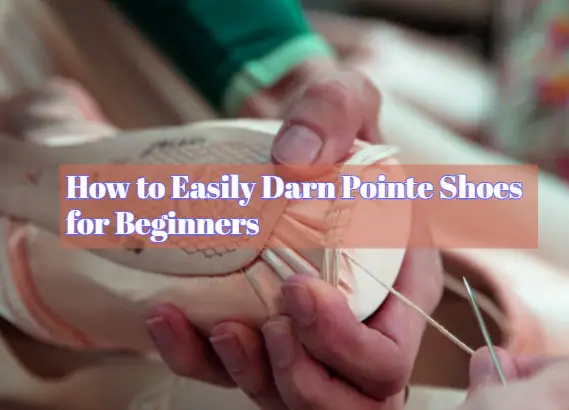As a new ballet dancer taking pointe classes for the first time, you’ve likely heard about the importance of darning your pointe shoes. But what exactly is darning and why is it so critical for preserving your shoes? In this beginner’s guide, I’ll walk you through everything you need to know to start darning those delicate pointe shoes and keep dancing.

Why Darn Your Pointe Shoes?
Darning reinforces the box and platform of your pointe shoes, providing extra stability and structure in high-wear areas. Without darning, pointe shoes can rip, tear and fall apart much faster. Darning protects your investment in pointe shoes, allowing them to last through many more classes and rehearsals before needing replacement.
For beginners building up foot and ankle strength, quality darning ensures your pointe shoes provide the support you need while en pointe and reduces the risk of injury. Taking a few minutes to darn each pair regularly will maximize their lifespan and keep your toes safe in class.
Ways to Darn Pointe Shoes for Beginners
Now that you’re sold on the benefits, let’s cover the most common darning methods for pointe shoe newbies:

Traditional Hand Darning
The most basic darning technique is hand darning with a needle and thread. While more time consuming than glue or patches, hand darning allows you to reinforce stressed areas one stitch at a time. All you need is a darning needle, cotton thread (avoid slippery polyester thread) and scissors.
First, identify areas inside the shoe needing reinforcement by examining the insoles. Look for thinning fabric or tiny tears/holes near the platform and box. Mark problem spots with chalk. Holes, rips or excessive fraying in the outer satin generally can’t be repaired with darning – these require patches instead.
Thread your darning needle with an 18-inch length of cotton thread. Select a thread colour close to the shoe’s inner lining. Knot one end then begin stitching over the marked areas using a simple running stitch, weaving the thread back-and-forth to create a woven pattern of threads. Use small 1/8-inch stitches and try to maintain even tension.
Once you’ve reinforced the marked spot, knot the thread on the inside of the shoe. Trim excess thread ends close to the knots. Use this process to hand darn multiple areas one at a time. Focus on high-wear zones like the inner platform but don’t over-darn less stressed spots.
Glue Darning
For quicker darning, liquid darning glues allow you to rapidly reinforce pointe shoes. Look for fabric glue formulated specifically for pointe shoes and safe for use inside shoes touching the foot.
Start by identifying weak points needing darning glue. Lightly roughen the inner fabric surface with fine-grain sandpaper so the glue adheres better. Apply a thin layer of glue over worn areas using the applicator bottle’s tip. Smooth with a toothpick or let dry untouched for a mess-free quicker option.
Allow the glue to fully dry for 24 hours before wearing the shoes again. Test flexibility after glue dries to ensure you haven’t made the shoe too stiff with excessive glue. If needed, apply additional thin layers of glue until you achieve the desired stiffness in high-wear zones.
Patch Darning
Satin and canvas pointe shoe patches offer an easy option for reinforcing holes, rips or extensive fraying in the upper satin and outer fabric. Once the outer satin tears, hand darning won’t repair it properly. Using patches combines the benefits of traditional darning with reinforced fabric applied over damaged upper areas.
Cut a patch slightly larger than the damaged area from thin sailcloth, canvas or satin. Avoid thick patches that could feel uncomfortable inside the shoe. Round the patch corners to prevent peeling.
Apply a thin layer of fabric glue around the damaged satin/fabric area. Centre the patch over the damage and press down firmly. Let dry completely then add a top layer of glue over the entire patch to seal the edges.
Once dry, the patch will provide additional support to prevent further ripping or tearing of the damaged satin. Trim any excess patch material hanging over shoe edges for a smooth finish.
Tips for Successful Pointe Shoe Darning
Darning your pointe shoes for the first time can be intimidating but gets easier with practice. Follow these tips for beautifully darned shoes that stand up to classes:
- Inspect shoes before and after each wear to look for new areas needing darning. It’s much easier to reinforce tiny holes before they grow bigger.
- Rotate between at least two pairs of pointe shoes so you aren’t always dancing on the same pair each day. Letting shoes fully dry out and rest between wears makes darning less frequently needed.
- Only darn areas that actually need reinforcing based on visible wear – don’t waste time preemptively darning brand new shoes. Focus darning on the inner platform and box fabric.
- Use matching thread colours for a seamless look. With hand darning, keep stitches tiny and evenly spaced.
- When glue darning, apply light even layers of glue to avoid stiffening the shoe too much. Thin glue layers are better than one thick application.
- Don’t over-darn less stressed areas like the vamp and sides. Excessive darning makes shoes uncomfortably stiff.
- Mix up your darning techniques – use hand darning for targeted spot fixes combined with patches on torn satin areas and glue over high-wear zones.
Alternate Methods for Protecting Your Pointe Shoes
In addition to standard darning methods, some other creative ideas for prolonging your pointe shoes include:
- Covering the platform with soft tape or moleskin to reduce friction that wears down fabric. Change tape frequently as it becomes grimy.
- Placing toe caps over the satin box temporarily protects the fabric while breaking in new shoes.
- Sewing elastic straps across the vamp opening to keep shoes firmly on. Straps distribute stress over more satin area.
- Spraying the inner lining with diluted alcohol or vodka helps kill bacteria and odours to keep shoes fresher.
- Allowing shoes to dry out slowly overnight after dancing avoids damage from rapid drying. Stuff with tissue rather than crumpling.
- Carrying shoes in a soft drawstring bag protects from getting crushed or distorted in your dance bag.
How Often Should You Darn Your Pointe Shoes?
For beginners, plan to darn pointe shoes every 2-4 wears as you are breaking them in and adjusting your technique. Check for holes, thinning fabric and loose stitches after each class, then darn as needed based on wear.
Once broken in, you can likely go 6-10 full wears between darning sessions. Again, inspect shoes regularly and darn whenever you spot new holes, tears or excessive fraying, don’t wait until the next scheduled darning.
The more frequently and thoroughly you darn throughout your shoe’s lifespan, the longer it will last before needing replacement. Don’t fall behind on darning; repair damage promptly to avoid bigger issues. With care, properly darned pointe shoes can last through 20-30 classes or more.
Conclusion
As you advance in your pointe training, darning will likely become as instinctual as sewing elastic straps or breaking in stiff new shoes. Don’t let the tiny holes or frayed edges you’ll encounter intimidate you. Now that you know the main darning techniques and when to apply them, you can keep those satin shoes in beautiful shape performance after performance.
Remember to inspect shoes frequently, reinforce high-wear areas promptly and rotate pairs to maximize longevity. Embrace darning as an essential ritual of ballet. When you take time to care for your shoes properly, they’ll support you beautifully on pointe.
I hope this beginner’s guide provides helpful tips and guidance on keeping your pointe shoes performing beautifully through proper darning care! Let me know if you have any other pointe shoe questions.
FAQs
What supplies do I need to get started darning pointe shoes?
You’ll want a darning needle, cotton thread in colors matching your shoe lining, fabric glue formulated for pointe shoes, thin patches and scissors. Sandpaper is also helpful for roughening areas before gluing.
Should I hand darn or use glue?
Try combining approaches. Use hand darning for targeted spot fixes and patches where the satin is damaged. Apply glue darning over larger high-wear areas like the platform. Mixing methods gives the best reinforcement.
How can I avoid damaging satin when hand darning?
Use a needle size specifically for pointe shoes – too large a needle hole can tear delicate satin. Keep hand stitches very tiny, evenly spaced and only darning in stressed areas that need it to avoid excess holes in the satin.
Is super glue acceptable for darning pointe shoes?
Shoe glue or seam sealant designed for pointe shoes is recommended over household super glues. Pointe shoe glues remain more flexible to avoid excess stiffness. Check that any glue is non-toxic and safe for skin contact when dry.
Should I darn brand new pointe shoes before wearing?
It’s best not to over-darn areas that aren’t stressed yet in new shoes. Just wear them for a few classes first, then begin reinforcing spots showing wear using stitches, patches or glue as needed.
How can I make darned areas less visible?
Use thread or patch colours closely matching the shoe’s inner lining for a seamless look. Keep hand stitches tiny and evenly spaced to “blend in”. Trim any patch or thread edges hanging over shoe seams for a tidier finish.
What are some warning signs my shoes need darning asap?
Don’t delay darning shoes showing new holes in the platform, ripped or thinning satin around the shoe box, excessive creasing/wrinkling at the back seams, or pinked/frayed edges where layers are separating. Reinforce immediately.
Should I darn just one spot or an entire area?
It depends on the damage. For isolated small holes darn just the hole. But for general thinning fabric in a high-wear zone, darn the whole platform or box area to evenly reinforce and prevent bigger holes.
How do I wash pointe shoes in between darning to keep them clean?
Mix a gentle soap like Ivory with water in a small bucket. Swish shoes gently, then rinse. Stuff with clean tissues and allow to fully air dry. Never machine wash or dry pointe shoes.



